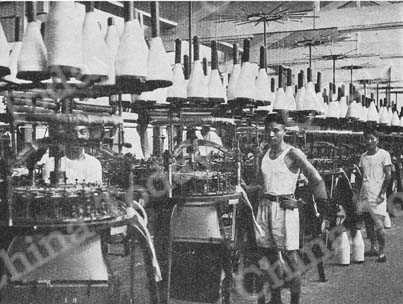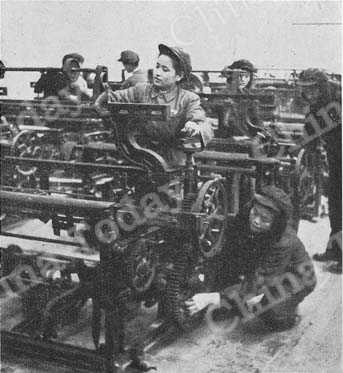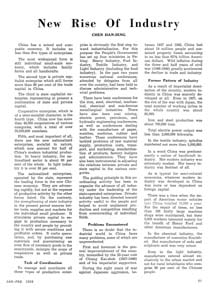China has a mixed and composite economy. It includes no less than five types of enterprises.
The most widespread form is still individual small-scale economy, which includes family farms and all handicrafts.
The second type is private capitalist enterprise which still forms more than 80 per cent of the trade capital in China.
The third is state capitalist enterprise, representing at present a combination of state and private capital.
Cooperative enterprise, which is of a semi-socialist character, is the fourth type. China now has more than 46,000 cooperatives of various categories, with a total of over 30,000,000 members.
Fifth, and most important of all, there are the new nationalized enterprises, socialist in nature, which now account for half of China's modern industrial production. In heavy industry, the nationalized sector is about 80 per cent of the whole. In light industry it is over 30 per cent.
The nationalized enterprises, operated by the state, represent the leading force in the new Chinese economy. They are advancing rapidly, but not at the expense of productive activity by the other forms listed. On the contrary, the strengthening of state industry in the present period ensures better tools, supplies and markets for the individual small producer. It stimulates private capital to engage in production necessary to the country and people by providing it with secure conditions and profitable orders. It curbs speculation, and, by purchasing raw materials and guaranteeing an even flow of necessary goods to the countryside, enlarges the scope of cooperative as well as private trade.
Task of Coordination
To manage and coordinate all these types of productive enterprise is obviously the first step toward industrialization. For this purpose the People's Government has set up four ministries in Peking: Heavy Industry, Fuel Industry, Textile Industry, and Light Industry (including the food industry). In the past two years numerous national conferences, attended by delegates from all over the country, had been held to discuss administrative and technical problems.
There have been conferences for the iron, steel, electrical, mechanical, chemical and non-ferrous metallurgical industries. There have also been coal mining, electric power, petroleum, and hydraulic engineering conferences, as well as conferences dealing with the manufacture of paper, matches, medicine, rubber and leather. These conferences have tackled problems of raw material supply, production costs, transport, and marketing, standardization of products, factory budgets and administration. They have also been instrumental in adjusting the relations between private and state capital in the various categories.
The guiding principle in this coordinating activity has been to organize the advance of all industry under the leadership of the state-operated enterprises. Private industry has been directed toward activity useful to the people and helped to avoid unplanned production and competition resulting from overcrowding of individual fields.
Problems Encountered
There is no doubt that the industrial world in China faces many problems, some of which are unprecedented.
First and foremost is the general impoverishment of the country, intensified by the 22-year rule of Chiang Kai-shek (1927-1949) and of his imperialist supporters.
During the eight years of war against Japanese aggression, between 1937 and 1945, China lost about 10 million people and sustained property losses amounting to no less than 62 1/2 billion American dollars. Wild inflation during the three and half years of civil war (1946-1949) greatly accelerated the decline in trade and industry.
Former Pattern of Industry
As a result of imperialist domination of the country, modern industry in China was scarcely developed at all. Even in 1937, on the eve of the war with Japan, the total number of working lathes in the whole country was about 90,000.
Iron and steel production was about 700,000 tons.
Total electric power output was less than 2,000,000 kilowatts.
In the textile industry, spindles numbered not more than 5,000,000.
In a word China was predominantly a nation of handicraft industry. Her modern industry was extremely modest. Her heavy industry was feeblest of all.
As is typical for semi-colonial economics, whatever modern industry was developed in China was more or less dependent on foreign capital.
There was a time when the import of American motor vehicles into China totalled 10,000 a year. For the repair of these, no less than 100 fairly large machine shops were maintained, but their 3,000 workers laboured mainly for the benefit of Henry Ford and other American manufacturers.
In the chemical industry, the manufacture of cosmetics flourished. But manufacture of soda and sulphuric acid was very minor.
Even in the light industry, manufacture catered almost exclusively to the urban market and not for rural inhabitants who comprise 80 per cent of the Chinese people.
Successes in Reconstruction
When the Central People's Government was inaugurated in 1949 it faced a two-fold industrial problem: to restore industrial production and at the same time to correct all the defects derived from China's past status, so as to launch a new path for industrialization. This was by no means an easy task.
The iron and steel industry, for instance, was 90 per cent destroyed between 1937 and 1949. Electric power capacity was 50 per cent destroyed during the same period. Moreover, the Japanese surrender practically denuded China's Northeast - where most of industry is located - of technicians. This was because it had been the policy of the Japanese, who occupied the area from 1931 to 1945, to confine such work to their own nationals. As a result, when the industrial plants in the Northeast were restored by the Regional People's Government, many technicians and skilled workers had to be recruited from east and south China.
Nevertheless the task was successfully carried out. In the past two years the Northeast has achieved speedy industrial recovery, and factories in other administrative regions have also been resuscitated.
The cement factories at Lanchow in the Northwest, and in Chungking in the Southwest; the iron mines in south Chahar and in the Northeast; the paper factories in Szechuan and Kwangtung; the manufacture of steel rails in an important steel works in the Southwest: these are all examples of successful restoration.

Chinese textile industry is more productive, and its workers are better paid, than at any time in the past.
As early as October 1950, 82.4 per cent of all textile spindles and 84.2 per cent of all power looms in the country had been put to work.
Basically the restoration of modern industrial production in China has been guaranteed by the advance of political democracy for the people. It has been achieved by the united efforts of workers, peasants, the middle class, and the patriotic industrialists, led by the People's Government.
Modernization and industrialization have been the common aim, as modernization and industrialization are the basis for improving people's livelihood. It has been a constant aim of our economic policy to guarantee that the progress of industry and the improvement of the workers' livelihood go hand in hand.
Better Life for Labour
Statistics from the Northeast show that average wages in that region increased by 27 per cent in 1949, by 12.5 per cent in 1950, and by an estimated 10 per cent in 1951. There has been a more or less similar rise in other administrative regions.
The People's Government in 1950 promulgated a safety and health law for factories and installed a system of factory inspection. As a result, sickness and deaths in textile factories in Tientsin, for instance, decreased by 62 per cent in 1950.
The Labour Insurance Law was published in 1951. Since last May, all factories employing 100 or more workers have taken out labour insurance. In other words, some 2,300,000 industrial workers and staff people, or about 10,000,000 people if the families are included, are protected by this law. In the nationalized textile mills, workers' insurance is equivalent to 12 to 15 per cent of the total wage.
Many sanatoria and homes have been set up for disabled, old and retired workers. More than 1,700 factories have organized workers' clubs. Workers' living quarters have already been greatly improved in many places.
Workers have made great advances in their culture. An estimated 1,300,000 have joined study classes of one kind or another.
The Chinese worker is no longer a slave of the machine. He now feels a new zest for life. He knows that he is a master of the country. In the factory, he has practical experience of the fact that every step in increasing production is a step forward in his earnings and general welfare. Instead of being docile and passive, he now exhibits initiative.
The productive enthusiasm of labour, its support of the policy of rapid restoration and industrialization, is the main moving force in the new rise of Chinese economy. This enthusiasm and this support find organized form - through the trade unions - in two great movements, the rationalization movement and production emulation (work competitions).
Workers Raise Productivity
In textile and other factories, during 1950 alone, no less than 24,000 proposals for administrative and technical improvements were made by the workers and adopted by management. Competition groups have been organized and involve over 2,220,000 workers in all.
Thanks to the enthusiasm of labour, backed by improved planning and administration, factories in many different industries, especially in iron and steel, produce from four to eight new records during one month. In the large Ta Chang silk filature in Wusih, the 1951 production was the highest in fourteen years in both quantity and quality. In 1950 all textile factories in the country taken together exceeded their highest production records of the past. Total yarn production in 1950 was 0.28 per cent higher than in 1930, the previous all-time high. In cloth production it was 7.8 per cent higher than 1936, the previous peak in this branch.
Private Industry Aided
This situation applies to both state and private industry. Under the leadership and with the support of the former, the latter is enjoying prosperity.
In 1950 the Ministry of Heavy Industry placed orders with many private factories. Two-thirds of the orders for steel manufacturers and one-third of those for electric appliances went to privately owned plants. State textile mills also passed on semi-finished goods to private mills for further processing.
Compared with 1949, yarn production increased 39.39 per cent in 1950; while power loom production increased 59.11 per cent in the same year. Printing and dyeing in private factories increased 33 per cent. Privately - controlled gunny-sack production increased by 76.08 per cent in the same year.
Private industry has been greatly benefitted by the new flood control projects. In 1951, more than 200 private workshops, including some 70 steel and machine shops in Shanghai, filled orders for implements and material used on the great Huai river project. These factories employ a total of 30,000 workers.

Girls, who never did this kind of work before, repair machines damaged by the Japanese and Kuomintang.
In both private and state factories, remarkable progress has taken place. Waste of materials has been greatly reduced in the gunny-sack mills in Tientsin. In Canton, certain steel processes which used to require forty days now take only twenty-eight. In another steel plant, in the Southwest, 94 per cent of the products are up to standard, as compared to only 70 per cent formerly.
Base for New Progress
The average daily coal production per miner in the Northeast was 0.33 tons per day in 1946. It is now nearly double this figure. In 1949 the value of industrial products in the Northeast represented only 35 per cent of the total industrial and agricultural production. By 1950 it had risen to 43 per cent, and the 1951 target was to increase it to 47 per cent.
Statistics for the entire country show that coal production increased nearly one and a half times between 1949 and 1950, production of machinery three times, cement nearly four times, steel more than seven times, and pig iron eleven and a half times. The textile plan for 1951 was to increase the number of spindles by 162,000; and to manufacture 2,000 machine looms.
This is the outline of the new rise of industry in China. To the casual observer it may appear to be merely "restoration." But a true understanding of the nature of the present democratic transformation of China, and of the actual industrial progress made so far, reveals, that during this process of restoration, many of the former defects have been corrected. It shows that China is already well on the way towards a genuine process of industrialization that will pave the way for prosperous livelihood for her people and contribute to world peace.


 Copy Reference
Copy Reference 